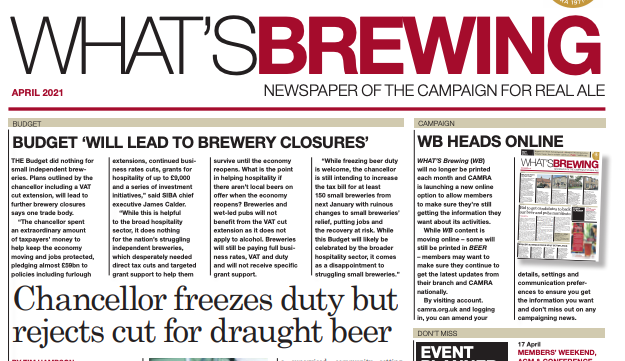Great expectations

It’s still the time of year when beer writers up and down the land don their Mystic Meg costumes and tell us what we’ll be drinking in the next 12 months. Rather than being based on any actual information (or genuine clairvoyant ability), these divinations tend to lean to the aspirational – attempts to bring a new style or trend into being by force of will alone. I’ve decided to take a different path and just ask the brewers what’s going on.
I’ve seen vague mentions of stout as a trend for 2024. This is no doubt due to the growth of the category across 2023, from 6.9 per cent of total beer sales to 8.1. But the only brewer to highlight this style was Robinsons, which is releasing a keg coffee stout under its collaborative project, Unicorn Brewing. I think stout is firmly embedded and will continue to grow, but trends are not annual, running from January to January. A lot of brewers already have a stout within their core range and I have written about the increase in nitro and barrel-aged stouts in What’s Brewing for well over a year now. Due to the duty increase, the number of strong barrel-aged examples will likely decline. Plenty of stout, but perhaps slightly less variety of higher ABV.
More important, I think, will be the continued popularity of pale ales of all kinds. This is certainly a trend that has been enjoying dominance for several years and it shows no sign of abating. A lot of brewers have mentioned a focus on developing or improving the quality of lower-strength pales, around the 3.4 per cent mark, having noticed increasing demand for them. There is also a duty efficiency for brewing to this strength. And on that note, it is clear that more will be moving into the alcohol-free (0.5 per cent and under) space. There are new releases from Siren coming soon, for example, as well as new brands hoping to capture the market like functional alcohol-free brewers ON Beer.
A real area of growth is the use of English hops. I’ve spotted some exciting beers in the planning from the likes of Buxton, Oakham Ales, Wimbledon and Hobsons breweries. A lot of this output has been driven by the work that Charles Faram is doing to develop new English hop varieties, but many brewers are also building their own relationships. As Steve Sailopal of the alcohol-free Good Karma Brewing Co. said: “Our USP is zero hop air miles and being able to look our local hop farmers in the eye to thank them and give them big hugs.” That does sound like good karma.
A lot of brewers are understandably cautious about the future. The word survival is mentioned with depressing regularity. But rather than withdrawal, this seems to be manifesting in consolidation. Several breweries talked about focusing on their core range and brewing to meet demand at their own tap rooms, like Balance Brewing & Blending which is anxious to keep expanding and evolving after moving into its own space last year. It’s great to hear the Brewery of St Mars of the Desert say it is “less motivated by the internet and other breweries or whatever craft beer is supposed to be, much more by who we are and who our customers actually are”.
Many brewers echoed the sentiments of Kelly Sidgwick at Good Chemistry: “We’re feeling positive as a business, but less optimistic about the industry as a whole.”
Some are increasing their production in the coming year by investing in more kit, often to support the core beers at their foundations. Expect to see an increase in volume from Elusive Brewing, while Round Corner Brewing, previously heavily focused on cans and keg, is increasing its cask output.
Speaking of cask, sentiments are joyously positive. The new MD of the Buxton Brewery Company, Dom Metcalfe, makes an interesting point: “The doom and gloom of a declining category is driven by the drop back of Doom Bar, GKIPA and trad styles from trad brewers. Hence the sudden rebranding of best bitters to ambers and golden ales. We are unapologetic in our resolution to brew excellent cask beer, priced sensibly and widely available.”
Buxton is not alone in planning a seasonal calendar of cask ales, and putting it front and centre in its plans. We can also expect interesting cask releases in traditional and contemporary styles from Abbeydale, Roosters (which also has 47 limited releases scheduled for 2024!), Hobsons, Small Beer, Good Chemistry and many others. There are some fantastic looking collaborations taking place within these one-off brews. Collaboration has proved a great way for breweries to reach new audiences and learn from each other in recent years and I don’t expect that to stop any time soon.
Finally, it is noticeable that many breweries are looking to make as many of their beers vegan and gluten-free as possible, to make them accessible to the widest audience. This can only be good news for the long-term sustainability of the industry. This has always been a strength of breweries like Roosters, Good Chemistry and Brass Castle, which claims to brew the only gluten-free NEIPA in the country. It’s great to see others coming on board, like Siren which is working to improve its already delicious 3.4 per cent gluten-free session IPA, Lumina, this year.
And we have lots to celebrate in 2024. Milestone anniversaries for Hook Norton (175 years), Batemans (150 years), Church End (30 years) and UnBarred (10 years) for example.
Our brewers, it seems to me, are anticipating another year of very hard work in a difficult climate. But I get the impression that it’s a challenge they are facing with enthusiasm. I can’t put it better than DMC in Leeds, which is ready to have at it in 2024: “More collabs, more beers, more festivals, more events, just more.”

 view archive
view archive
 view events
view events